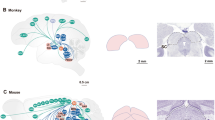Summary
Intracellular recordings of a distinctive class of directionally selective cell from the medulla of the locust,Locusta migratoria, optic lobe are described. Dye marking shows that these cells arborize in the distal part of the medulla, and project through the lobula complex. The cells are excited by upward movement and have receptive fields of about 20° in diameter. They are sensitive to a wide range of angular velocities from 0.02°/s to over 200°/s. The cells are sensitive to stationary flicker and have different latencies to dimming and brightening. Evidence is presented which suggests that directional computation depends, at least in part, on an inhibitory interaction between flicker sensitive channels.
Similar content being viewed by others
References
Barlow HB, Levick WR (1965) The mechanism of directionally selective units in rabbit's retina. J Physiol 178:477–504
Buchner E (1984) Behavioural analysis of spatial vision in insects. In: Ali M (ed) Photoreception and vision in invertebrates. NATO ASI series A, vol 74, Plenum NY, pp 523–621
Collett T, King AJ (1975) Vision during flight. In: Horridge GA (ed). The compound eye and vision in insects. Clarendon Press, Oxford, pp 437–466
Cooter RJ (1979) Visually induced yaw movements in the flying locust,Schistocerca gregaria (Forsk.). J Comp Physiol 131:67–78
DeVoe RD, Ockleford EM (1976) Intracellular recordings from the medulla of the flyCalliphora erythrocephala. Biol Cybern 23:13–24
DeVoe RD, Kaiser W, Ohm J, Stone LS (1982) Horizontal movement detectors of honeybees: Directionally-selective visual neurons in the lobula and brain. J Comp Physiol 147:155–170
Egelhaaf M (1985a) On the neuronal basis of figure-ground discrimination by relative motion in the fly. I. Behavioural constraints imposed on the neuronal network and the role of the optomotor system. Biol Cybern 52:123–140
Egelhaaf M (1985b) On the neuronal basis of figure-ground discrimination by relative motion in the fly. II. Figure detection cells, a new class of visual interneurons. Biol Cybern 52:195–209
Hausen K (1981) Monocular and binocular computation of movement in the lobula plate of the fly. Verh Dtsch Zool Ges 1981:49–70
Horridge GA (1978) The separation of visual axes in apposition compound eyes. Philos Trans R Soc Lond B 285:1–59
Horridge GA, Sandeman DC (1964) Nervous control of optokinetic responses in the crabCarcinus. Proc R Soc Lond B 161:216–246
Kien J (1974) Sensory integration in the locust optomotor system. II. Direction selective neurons in the circumoesophageal connectives and the optic lobe. Vision Res 14:1255–1268
Mimura K (1972) Neural mechanisms, subserving directional selectivity to movement in the optic lobe of the fly. J Comp Physiol 80:409–437
Morgan MJ (1980) Analogue models of motion perception. Philos Trans R Soc Lond B 290:117–135
Rainey RC (1976) Flight behaviour and features of the atmospheric environment. In: Rainey RC (ed) Insect flight. Symp R Entomol Soc Lond 7:75–112
Riehle A, Franceschini N (1984) Motion detection in flies: Parametric control over on-off pathways. Exp Brain Res 54:390–394
Srinivasan MV, Dvorak DR (1980) Spatial processing of visual information in the fly: Characteristics and functional significance. J Comp Physiol 140:1–23
Strausfeld (1984) Neuroanatomy of the blowfly's visual system. In: Ali MA (ed) Photoreception and vision in invertebrates. NATO ASI series A, vol 74. Plenum NY, pp 483–522
Thorson J (1966) Small-signal analysis of a visual reflex in the locust. I. Input parameters. Kybernetik 3:41–53
Torre V, Poggio T (1978) A synaptic mechanism possibly underlying directional selectivity to motion. Proc R Soc Lond B 202:409–416
Wilson M (1975) Angular sensitivity of dark and light adapted locust retinula cells. J Comp Physiol 97:323–328
Usherwood PNR, Grundfest H (1965) Peripheral inhibition in skeletal muscle of insects. J Neurophysiol 28:497–518
Zaagman WH, Mastebroek HAK, Buyse T, Kuiper JW (1977) Receptive field characteristics of a directionally selective movement detector in the visual system of the blowfly. J Comp Physiol 116:39–50
Author information
Authors and Affiliations
Rights and permissions
About this article
Cite this article
Osorio, D. Directionally selective cells in the locust medulla. J. Comp. Physiol. 159, 841–847 (1986). https://doi.org/10.1007/BF00603737
Accepted:
Issue Date:
DOI: https://doi.org/10.1007/BF00603737




